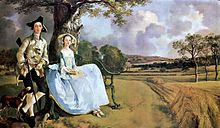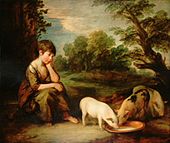Thomas Gainsborough

Thomas Gainsborough , RA FRSA (born May 14, 1727 in Sudbury , Suffolk , † August 2, 1788 in London ) was an English painter who devoted himself particularly to portrait and landscape painting. Along with William Hogarth and Joshua Reynolds, he is considered the most important English painter of the 18th century.
Life
Early years
Gainsborough was born the fifth son of the cloth merchant John Gainsborough and was baptized on May 14, 1727. Because his early landscape drawings made an impression in family circles, his father sent him to London in 1740 to enable the boy to study art. There Gainsborough stayed in the vicinity of Hubert-François Gravelot , Francis Hayman , William Hogarth and other artists from London's St. Martin's Lane Academy . As early as 1743, the precocious artist had his own studio in Hatton Garden. And at the age of 19, in 1746, he married sixteen-year-old Margaret Burr, probably an illegitimate daughter of the Duke of Beaufort. In the same year he took part in the decoration of the Foundling Hospital in London with paintings.
Moderate success as a landscape and portrait painter
The successes as a painter were initially not great. So he had to stay afloat for a while with imitations of Dutch landscapes from the 17th century. In 1748 he left London and returned to Sudbury. There he mainly painted small-format portraits of nobles in front of a landscape background, but still had difficulties establishing himself as a painter, so that in 1752 he moved to Ipswich, where he mainly stayed in music circles, but also painted a few portraits and landscapes. But the customer base remained limited here too, so that Gainsborough moved to fashionable Bath in 1759 .
Breakthrough as a painter
The English eccentric Philip Thicknesse was one of Gainsborough's early patrons , who introduced him to more distinguished social circles in London and Bath. His friends soon included the actor David Garrick and the musician Johann Christian Bach . In 1761 and 1763, the artist took part in London art exhibitions with lively painted portraits, which are in deliberate contrast to Joshua Reynolds' historicizing portraits. In general, he retained a certain degree of independence in his portraits and landscapes. Nevertheless, as a founding member of the Royal Academy of Arts , London, led by Reynolds, he exhibited a portrait of Isabella Lady Molyneux at its first public exhibition in 1768.
Split relationship with the President of the Royal Academy of Arts
Gainsborough's relationship to the Royal Academy, with its favoring old continental painting traditions, remained divided, however, because his sensualistic style of painting gave preference to color over academic drawing. In 1774 Gainsborough finally moved to London, where he established himself as a portraitist, and even received numerous commissions from the English royal family, but was also in constant competition with Academy President Reynolds because he preferred sensitive "fancy pictures" against a rural background and not historical pictures Painted “great style”. On August 2, 1788, Gainsborough died of cancer.
power
It is noticeable in his portraits that Gainsborough preferred the delicate and casual to the representation of an artificial, stone representation, which is why he did not have his figures pose in the studio but in the great outdoors in front of a landscape background. A typical example of this is the portrait of William Hallett and his wife Elizabeth on their Morning Walk (1785, London, National Gallery ). These portraits also show how fascinated Gainsborough was with fabrics and fashionable clothing.
The artist turned against strict academicism at an early stage and tried to transfer the idealization of the motifs propagated at the time into a more subtle way of pictorial representation in his painting . For Gainsborough, this could only be achieved through sensitivity , which means that the viewer should not only grasp a picture with his prior knowledge of the ideal motifs he had read, as was often the case at the time, but penetrate the picture with personal empathy . This sensitivity is particularly evident in his depictions of poor people against an idyllic rural background, for example in his famous Cottage Girl with Dog and Pitcher (1785, Dublin, National Gallery of Ireland) or in his depiction of a girl with pigs (approx. 1781-82).
Gainsborough's art was influenced by the Dutch artists Jacob Izaaksoon van Ruisdael , Meindest Hobbema and Jan Wijnants , by the French Antoine Watteau and Jean-Honoré Fragonard (painterly ductus, landscape background), Hubert-François Gravelot and Anthonis van Dyck, and Venetian painting.
Although an influence of Gainsborough's conception of nature on the early landscapes of John Constable can be recognized, otherwise his oeuvre hardly had a lasting impact on the following generations of artists.
Exhibitions in Germany (selection)
- 2018: Thomas Gainsborough: The Modern Landscape , Hamburger Kunsthalle , Hamburg
Works (selection)
- The lawyer Joshua Grigby III. (Berlin, Staatliche Museen, Gemäldegalerie, inv. No. KFMV 275), around 1760–65, oil on canvas, 127.5 × 102.2 cm
- Mrs. Siddons (London, National Gallery, inv.no.NG 683), 1785, oil on canvas, 126 × 99.5 cm
- Mrs. Thomas Hibbert (Munich, Neue Pinakothek, inv.no.FV4), 1786, oil on canvas, 127 × 101.5 cm
- Mr. and Mrs. Andrews , London, National Gallery, 1749/50, oil on canvas, 69.8 × 119.4 cm
- The Blue Boy , around 1770
- Cottage Girl with Dog and Pitcher , Dublin, National Gallery of Ireland, 1785
- Landscape in Suffolk , Vienna, Kunsthistorisches Museum (not on display for unknown reasons)
Rediscovered Chalk Drawings In
2017 it became known that the Royal Library of the Royal Collection in Windsor was in possession of 26 previously unknown chalk drawings by Gainsborough, which were found in a library volume of sketches that had previously been incorrectly attributed to Edwin Landseer .
literature
- Lord Ronald Charles Sutherland Gower: Thomas Gainsborough. London 1903 (various reprints) a. a. ISBN 978-1-296-96641-6 .
- William T. Whitley: Thomas Gainsborough. London 1915.
- Ellis K. Waterhouse: Gainsborough. London 1958.
- John Hayes: The Drawings of Thomas Gainsborough. London 1970.
- John Hayes: The Landscape Paintings of Thomas Gainsborough. 2 volumes, London 1982.
- Amal Asfour, Paul Williamson: Gainsborough's Vision. Liverpool University Press 1999.
- Werner Busch : Gainsborough's Blue Boy - creating meaning through color. In: Städel yearbook. NF 17, 1999, pp. 331-348 ( [1] PDF).
- Bettina Gockel: Art and Politics of Color: Gainsborough's Portrait Painting. Berlin 1999.
- Michael Rosenthal: The Art of Thomas Gainsborough. New Haven and London 1999.
- John Hayes (Ed.): The Letters of Thomas Gainsborough. New Haven and London 2001.
- Hugh Belsey: Gainsborough at Gainsborough's House. Paul Holberton, London 2002.
- Michael Rosenthal, Martin Myrone: Thomas Gainsborough. Tate Gallery, London 2002.
- William Vaughan: Gainsborough. Thames and Hudson, London 2002.
- Susan Sloman: Gainsborough's Landscapes: Themes and Variations. Exhibition catalog, Holburne Museum of Art 2011.
- James Hamilton: Gainsborough: A Portrait. Weidenfeld and Nicolson, London 2017.
- Katharina Hoins, Christoph Vogtherr (ed.): Thomas Gainsborough: The modern landscape. Exhibition catalog, Hamburger Kunsthalle, Munich 2018, ISBN 978-3-7774-2996-0 .
- William Michael Rossetti: Gainsborough, Thomas . In: Encyclopædia Britannica . 11th edition. tape 11 : Franciscans - Gibson . London 1910, p. 388–389 (English, full text [ Wikisource ]).
Web links
- Literature by and about Thomas Gainsborough in the catalog of the German National Library
- Works by and about Thomas Gainsborough in the German Digital Library
- Search for Thomas Gainsborough in the SPK digital portal of the Prussian Cultural Heritage Foundation
- Works by Thomas Gainsborough at Zeno.org .
- Werner Busch: Gainsborough's "Blue Boy" - creating meaning through color (PDF; 11.4 MB)
- A portraitist as a landscaper Critique of the exhibition Thomas Gainsborough - The Modern Landscape in the Hamburger Kunsthalle (March 2 to May 27, 2018). In: Cover culture magazine
- 365 paintings: Gainsborough
Individual evidence
- ↑ See William T. Whitley: Thomas Gainsborough. London 1915, pp. 2-3.
- ↑ John Keay: Eccentric Travel Around the World. Verlag Klaus Bittermann, Berlin 2007, ISBN 3-89320-109-2 , p. 24 and p. 25.
- ↑ Dalya Alberge: Thomas Gainsborough sketches newly discovered at Windsor Castle. In: The Guardian . July 9, 2017. Accessed July 10, 2017.
- ↑ Naomi Rea: Dozens of Previously Unknown Thomas Gainsborough Drawings Are Discovered in a Library Book. In: artnet news of July 10, 2017. Accessed July 10, 2017.
| personal data | |
|---|---|
| SURNAME | Gainsborough, Thomas |
| BRIEF DESCRIPTION | English painter |
| DATE OF BIRTH | May 14, 1727 |
| PLACE OF BIRTH | Sudbury (Suffolk) |
| DATE OF DEATH | August 2, 1788 |
| Place of death | London |



